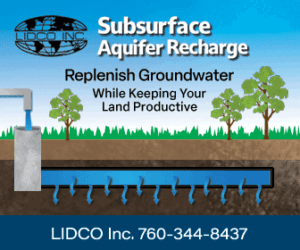 By Kevin Kauffman PE, Managing Partner of The Water Group, LLC
By Kevin Kauffman PE, Managing Partner of The Water Group, LLC
More progress has been made in 2023 than I recall happening in the past 25-years in recognizing the value of the storage capacity of the San Joaquin and Sacramento groundwater basins. This is a good thing and will ultimately help all groundwater subbasins in the State achieve sustainability.
With the Sustainable Groundwater Management Act of 2014, most subbasins in the State have now complied, forming agencies to assure subbasin sustainability by 2040. Just as sustainability plans are approved two additional things happen to make our communities more aware of using subbasins as storage reservoirs. First comes the wet water year of 2022-23. Second, our Federal and State governments recognize the opportunity to fund groundwater recharge (GWR) projects with surface water surplus to the needs of water right holders.
Artificially replenishing our groundwater subbasins with GWR projects has now been accepted throughout the State. The Central Valley groundwater basins have been identified as reservoirs that can replace the abandoned surface water reservoirs planned but never built from the original State water project.
Again, artificial replenishment of our groundwater subbasins happens when we develop what is more commonly known as GWR projects. There are many methods to implement GWR. The following list of the GWR projects is believed to include every known method:
- Percolation Ponds or Spreading Basins, including detention/retention ponds.
- Streambed, canal, and lake leakage, including:
- rock-fords in streams and canals
- flashboard and inflatable dams in streams and canals.
- Exfiltration Galleries (aka reverse tile drains).
- Gravity vertical drain/down for injection above water table (includes dry and injection wells).
- Soil wick drains, Prefabricated Vertical Drains (PVD), and Parjana EGRP systems.
- Aquifer Storage and Recovery (ASR) Wells (aka Engineered Injection & Extraction Wells).
- Field Flooding.
- In-lieu recharge (opting to use surface water in-lieu of groundwater pumping).
Many of the above methods could be used as complementary components of the same GWR project. Depending on the surface water quality and groundwater depth, pretreatment may be necessary before using some of these methods. An analysis of local hydrology, drainage, soil, geology, and hydrogeologic conditions will usually identify a preference for or an exclusion of some of these methods.
pretreatment may be necessary before using some of these methods. An analysis of local hydrology, drainage, soil, geology, and hydrogeologic conditions will usually identify a preference for or an exclusion of some of these methods.
Experts in the GWR field of work compare the value of these methods as well, but my understanding is there is no one method guaranteed to meet every GWR project objective.
Although ‘in-lieu’ recharge is likely the most cost effective method, without a sound groundwater monitoring and water accounting system in-place, long-term success of such a program is uncertain.
All other methods can be compared and evaluated using life-cycle cost analysis comparisons and other steps in a value engineering exercise.
The Water Group distributes and installs Parjana Energy-Passive Groundwater Recharge Product (EGRP) systems in the western US. This method is included in number six above.
Parjana Engineering provides the system designs and product support from their home base in Michigan. The ‘knowledge center’ of their website (www.parjana.com) provides introductory information about how these systems can increase surface water infiltration rates by a factor of five to 10 times what natural soil conditions allow. Take a look at the website and found out more about how to increase recharge rates in the Central Valley.
DISCLAIMER OF RESPONSIBILITY; Waterwrights.net strives to provide its clients with the most complete, up-to-date, and accurate information available. Nevertheless, Waterwrights.net does not serve as a guarantor of the accuracy or completeness of the information provided, and specifically disclaims any and all responsibility for information that is not accurate, up-to-date, or complete. Waterwrights.net’s clients therefore rely on the accuracy, completeness and timeliness of information from Waterwrights.net entirely at their own risk. The opinions expressed in this report are those of the author and do not represent any advertisers or third parties.
ALL RIGHTS RESERVED. Copyright 2023 by WaterWrights.net






























